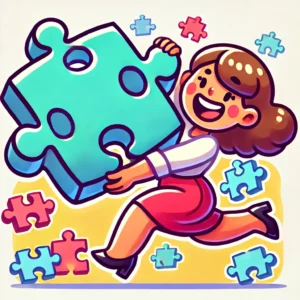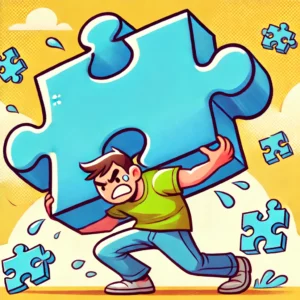Speed puzzlers know that if you memorize jigsaw puzzle pieces means that you are fast! It’s that the key to solving jigsaw puzzles quickly isn’t just about finding the right colors or patterns – it’s about recognizing piece shapes instantly. Whether you’re trying to improve your solving time or simply want a smoother puzzling experience, memorizing jigsaw piece shapes is an essential technique.

Jigsaw puzzles follow a set number of common piece shapes, and if you train your brain to spot them at a glance, you’ll dramatically cut down your solving time. Instead of aimlessly scanning every piece, you’ll be able to immediately categorize and place them where they belong.
Table of Contents
Let’s dive into how to memorize puzzle piece shapes and why understanding these tiny details makes a big impact on speed puzzling.
Why Memorize Jigsaw Puzzle Pieces? Shapes Matters
Most beginners focus on color and image details, which is helpful but inefficient when you want to go faster. Speed puzzlers take a different approach:
- They first sort by shape, not just color.
- They memorize common piece structures.
- They recognize where a piece belongs almost instantly.
When you train your brain to see shapes first, colors second, you’ll solve sections faster—especially those tricky sky pieces or repetitive patterns that would otherwise slow you down.
The Most Common Jigsaw Puzzle Shapes to Memorize
Jigsaw puzzles typically follow a set number of piece shapes. Train your brain to recognize these at a glance:
- Two tabs, two blanks – Standard middle pieces, these fit between other sections and are the most common.
- Three tabs, one blank – These are often near edges, providing structure but still connecting to multiple pieces.
- One tab, three blanks – Typically border pieces or found near defined sections of the puzzle.
- Four tabs (or four blanks) – Rare, but they stand out and are easier to place in a puzzle layout.
By taking time to memorize jigsaw puzzle pieces you will find basic shapes, you’ll immediately know where a piece might belong without scanning the entire puzzle table aimlessly.
How to Train Your Brain to Recognize Puzzle Shapes Faster
Step 1: Start Sorting by Shape Before Color
When you first dump out a puzzle, resist the urge to go straight for colors. Instead you need to make an intentional focus to memorize jigsaw puzzle pieces. Try different techniques to be familiar with the shapes:
- Separate edge pieces first.
- Group together pieces with similar shape structures (all two-tabs-twos-blanks in one pile, etc.).
- As you work on sections, place pieces based on shape first, then fine-tune with colors and patterns.
Step 2: Use the Flash Card Technique
Speed puzzlers use rapid exposure to train their eyes and memory. Try this simple trick:
- Take 10 puzzle pieces at random.
- Look at each piece for only one second before flipping it over.
- Try to recall how many tabs and blanks each piece had.
- Flip them back over and check how well you remembered them.
The more you practice this, the faster your brain will recognize patterns at a glance. This takes time but it’s the most effective way to memorize jigsaw puzzle pieces.
Step 3: Verbally Identify Shapes as You Solve
It may sound silly, but saying shapes out loud as you work helps solidify them in your memory. For example:
- “Three tabs, one blank—this goes near an edge.”
- “Two tabs, two blanks—this is a middle piece.”
- “One tab, three blanks—must be a border area.”
This kind of active recall speeds up how quickly your brain recognizes and places pieces.
Step 4: Practice on Different Puzzle Types

Not all puzzles have the same cutting style. Try different brands and styles:
Ribbon-cut puzzles (standard interlocking shapes)
Random-cut puzzles (more abstract, unique shapes)
Wooden puzzles (thicker pieces, different cut styles)
Practicing on different types of puzzles will make shape recognition second nature, no matter the puzzle design.
How Shape Recognition Helps in Speed Puzzling
If you’re working on improving your puzzle-solving time, shape memorization is a game-changer. Here’s why:
Reduces search time – Instead of scanning hundreds of pieces, you immediately know where a shape fits.
Engages muscle memory – Your brain will start placing pieces intuitively without as much conscious effort.
Speeds up difficult sections – Solid color backgrounds (skies, water, etc.) become easier to piece together.
Gives you an edge in competitions – Many puzzle tournaments are won by seconds or minutes -shape recognition can be your secret weapon!
Final Thoughts: The Power of Piece Shapes
Jigsaw puzzles are more than just an image waiting to be completed -they’re a game of strategy, memory, and recognition. The fastest puzzlers don’t just rely on luck -they use techniques like shape memorization to solve puzzles in record time. Afterall, the muscle you are using the most is your brain so this idea of knowing puzzle shapes helps with your brain health.
Whether you’re looking to shave minutes off your solving time or just want to puzzle more efficiently, training your brain to recognize and remember jigsaw piece shapes is one of the best ways to level up.
So next time you start a puzzle, focus on the pieces, not just the picture – you’ll be amazed at how much faster and more enjoyable puzzling becomes!
